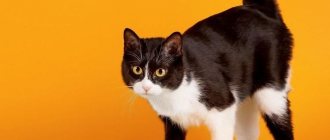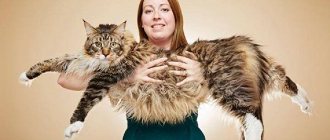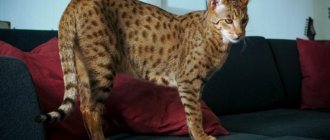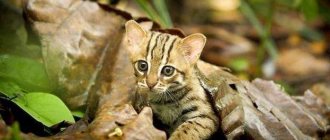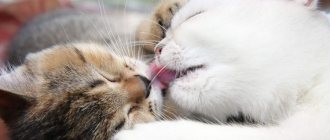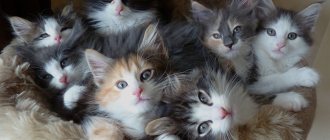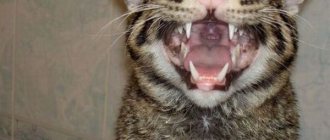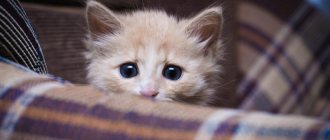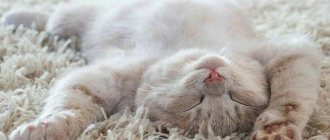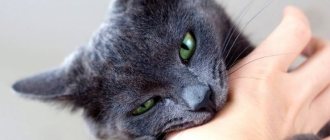Maneki-neko is a Japanese good luck charm in the form of a kitten with a raised paw. The name can literally be translated as "Inviting Cat". In Japan, it is also called the "Lucky Cat", "Luck Cat" or "Cash Cat". Traditionally, the amulet is made of ceramics and painted on a white background in different shades.
Origin story
Traditionally, the origin of the amulet is associated with Japanese history.
However, there are several versions of the appearance of a cat bringing good luck:
1. The cat saved the priest
One rich man was traveling on business. It began to rain heavily, and he hid under a tree when he suddenly noticed a cat. He waved his paw and seemed to be calling for him. The man followed him and soon saw the temple . As soon as he stopped, lightning struck the . So the cat saved the gentleman , and he, in turn, made donations to the temple, which saved him from poverty. Then, on the orders of the surviving man, a figurine of a cat was made. She became a symbol of good luck, first for him, and then for everyone.
2. Courtesan's cat
The courtesan Usugumo adored cats, and there were always several four-legged friends next to her, but she adored only one cat, like her own child. One night the girl woke up and wanted to leave the room, but her pet grabbed her clothes and did not let her pass. The guard came running at the noise. He decided that the cat had gone mad and cut off its head. But before that, the animal managed to grab the snake . Usugumo realized that the cat had saved her , and she missed her pet so much that one of her visitors gave her a figurine in the shape of a cat.
3. The story of the cat from Imado
One old woman living in Imado found herself on the verge of poverty, and she had to sell her beloved cat to get money for food. But they quickly ran out, and the woman again found herself in difficulty. And then in a dream a cat came to her and told her to make a figurine similar to him and sell it. People liked them so much that things started to improve. The old woman was no longer in need, and her work began to be symbolized with good luck.
Maneki-neko: general information
Maneki-neko is a Japanese good luck charm in the form of a kitten with its paw raised.
The appearance of the talisman is associated with Chinese wisdom, which says: “If a cat washes itself, expect rain.” The weather, as suggested in this proverb, will lead to the appearance of guests in the shop, who will go there to dry off and warm up, and therefore the bargain will go better.
The literal meaning of cat behavior has become figurative, and now if the animal is washing itself, one should wait for buyers.
Homeland of the figurine
Such cat figurines originated in Japan during the Edo era, which lasted from the beginning of the 17th century. to the middle of the 19th century. The first written mention of them dates back to the 50s. XIX century, presumably at the same time the image appeared.
Cat mascots are also popular in the Middle Kingdom, which is why in Western countries they are associated with Chinese establishments, not Japanese establishments. That’s why some people mistakenly call maneki-neko “jinmao” (“golden cat”).
Maneki-neko: symbol and meaning
A cat with its paw raised is considered a symbol of good luck. And this is true, but you need to pay attention to which paw is on top, the color of the figurine and the symbols . This will influence the goals. If you make the right choice, then luck and success will await you in your chosen field.
Important! It is recommended to place maneki-neko in front of the entrance to the house or in the first room from the entrance, facing those entering.
Some sources talk about another meaning: when the authorities banned the use of a special symbol, courtesans began to use a cat with a raised paw - it symbolized them, luring them to themselves . One way or another, it comes down to the fact that the cat promises joy.
Japan or China is the birthplace of the figurine?
The money Japanese cat
Maneki-neko or Alluring Cat comes from Japan. Since the figurine was brought to China, it immediately fell into the category of talismans most revered by the Chinese. In this country, its name sounds like “Lucky Cat”, and the legend of its origin has several versions. The cat is a symbol with ancient history, which is bought to attract money or good luck, and is also given to relatives and friends with the best wishes.
People often endow a talisman with miraculous powers, and a Japanese cat, waving its paw welcomingly, can be seen not only in homes, but also in shops, cafes or offices for success in business and prosperity in all endeavors.
Don't miss an interesting article on Talisman about the money toad - a powerful talisman for attracting wealth.
Why is the cat's paw raised?
There are three explanations for this:
- the raised left paw symbolizes the unification of people, the desire for communication;
- a raised right paw means calling good luck and money into the house;
- Raised two paws attract both people and money.
Important! Pay attention to the height of the raised paw: the larger it is, the better it attracts positive energy and well-being.
A mascot is also used to attract customers.
Longhaired Japanese Bobtail
This breed of cat also had other names: “Bobby” and “Chrysanthemum cat”, but it was officially recognized as the Japanese Longhaired Bobtail.
Appearance
Average body size, weight does not exceed 4 kg in large males. The body is muscular (not skinny). Due to the fact that the hind legs are longer than the short ones, this species has a specific uneven gait, with peculiar “jumps” of the rear part.
Unlike the short-haired modification, the long-haired ones do not have a flattened muzzle, but they do have a small depression at the transition from the forehead to the nose. The ears are set wide apart and may appear to tilt slightly forward when the cat is at rest.
The coat has an undercoat, but pronounced shedding occurs only in the spring and takes no more than 5-6 days. There may be a small “collar” of wool around the neck.
Character
The cat is very active and active, but unlike the short-haired cat, it is more jealous, so keeping it in a family that already has a dog or other pets is not worth it, as this can cause a sharp deterioration in its character. If she gets enough attention, she becomes a very gentle animal that adores her owners.
Health
Since this variety is a derivative of the original species, it is less resistant to various kinds of diseases. These cats must be fed with high quality ingredients. If you follow this rule, there will be no health problems.
Cats of these breeds are currently widespread only in Japan, and in the USA and Europe they remain quite rare and expensive, but their exotic appearance and wonderful character make them increasingly popular.
Video
about the breed:
Types of mascot
A white cat raising one paw brings intellectual development, helps maintain mental balance and a positive attitude.
A royal cat holding a gavel and wearing a scarf is suitable for executives. The items symbolize good luck and prosperity.
The warlike Maneki-neko , dressed in a kimono and with kittens around, protects the owner from harm and disease. The more kittens, the stronger the symbol itself.
The black figurine protects against the evil eye, damage and evil spirits and calls upon good forces.
The red figurine wards off illness and negativity, attracts positive energy, and helps restore strength.
Blue - identified with chastity and morality, but has a beneficial effect on spiritual development and helps to cope with internal emotions.
A pink cat relieves loneliness, makes its owner more attractive and confident, and relieves melancholy. Increases attraction and attraction. Helps you find new relationships or strengthen old ones.
Green – has a positive effect on memory, concentration, and increases creativity. Suitable for students and creative people.
Money Maneki-neko , which holds a coin or a bag, helps to maintain and increase financial status. A cat with two raised paws protects the house . If mice sit on his lap, this means fertility.
If both paws of a cat are raised , this is a talisman for preserving the hearth and family happiness. If a cat with kittens is a symbol of fertility.
The objects the cat is holding have different messages:
- the fan drives away evil spirits;
- a children's toy makes wishes come true;
- a gold coin or fish - for money;
- a flowering twig attracts love;
- fruits lead to the birth of a baby;
- oar - success in any endeavor.
Important Features: Symbolic Meaning
Now these figurines are made from different materials and have their own decorative features, which depend on the breadth of imagination of the manufacturer. Despite this, maneki-neko figurines have a common feature - a raised paw, almost always the right one.
Reasons why the paw is raised
The figurine can raise both legs, but, according to the most popular interpretation, there are different reasons for this:
- left - multiplying wealth (for business);
- right - attracting happiness (for family).
The general meaning of a raised paw is to invite guests and visitors whom the cat invites while washing itself. This association comes from a gesture that is special for Japan - with a raised hand, the caller bends and straightens his fingers.
A raised paw means increasing wealth and attracting happiness.
Modern figurines can be either static and solid (from one piece of material), or with a moving paw. The fact that the cat is waving it makes it even more obvious that she is inviting someone to come in.
Sometimes the figurine raises both paws, which doubles the effect it brings, adding a new one - getting rid of the feeling of loneliness.
Color
There are many superstitions in Japan. The classic white, red and black color of the maneki neko is reminiscent of calico cats, which the Japanese believe bring happiness to the home.
Now the figures are produced in a variety of colors, which have acquired new meanings:
- White color improves human energy and also symbolizes purity and goodness.
- Gold (or yellow) is needed to attract good luck in trading, it is associated with wealth.
- The black figurine will protect against negative energy and drive out demons.
- Red will increase the owner's determination. Such a cat will protect against diseases and accidents.
- A green cat will ensure success in studies.
- The blue color of the figurine will help attract health, increase vital energy and give strength to build good relationships with people.
- Pink is needed for good luck in love.
- Blue color will help those people who strive for spiritual improvement.
The color gold attracts good luck in trading.
Attributes
Sometimes a maneki-neko holds in his paw an object that attracts happiness and money, for example:
- a koban coin or a gold bar;
- a tablet with hieroglyphs;
- fish (carp);
- hammer;
- crystal ball - a symbol of wisdom;
- vegetables - pumpkin or radishes.
Other attributes of the figurine are a bandage around the neck, a bib and a bell.
The meaning of the talisman color
Most often, Maneki-neko is made in three-color colors . Usually these are white, black and red - symbols of good luck. Red-gold and white increase finances . There are also two-color cats. They themselves are white with spots of certain colors.
They have different meanings:
- white – kindness and innocence;
- black – protection from ill-wishers;
- gold – wealth, attracting profit;
- red – protection from harm;
- pink – love;
- red – good luck;
- green – new knowledge;
- blue – wisdom and peace.
Where to put the talisman?
Usually the cat is placed outside at the front door. If you live in an apartment, then in the hallway, so that you look at the door . To enhance the actions of the talisman, place it on a red cloth or pad.
Maneki-neko is a traditional Japanese figurine symbolizing good luck. Depending on the color of the cat and the attributes next to it, it changes its meaning and attracts into the house exactly what the person needs . It is important to make the right choice based on what you want so that luck really attracts you to the right side of life.
Subscribe to our Social networks
How to make your own talisman
You can create a figurine with your own hands from polymer clay or papier-mâché. It doesn’t matter what material Maneki Neko is made of, be it yarn or felted wool, the main thing is the mental attitude, and the cat figurine will definitely bring good luck to its owner.
As proof of your warmest feelings, you can give such a talisman to a loved one, thereby warning against failure and attracting good luck. The main condition is positive thoughts when creating a powerful amulet with your own hands.
